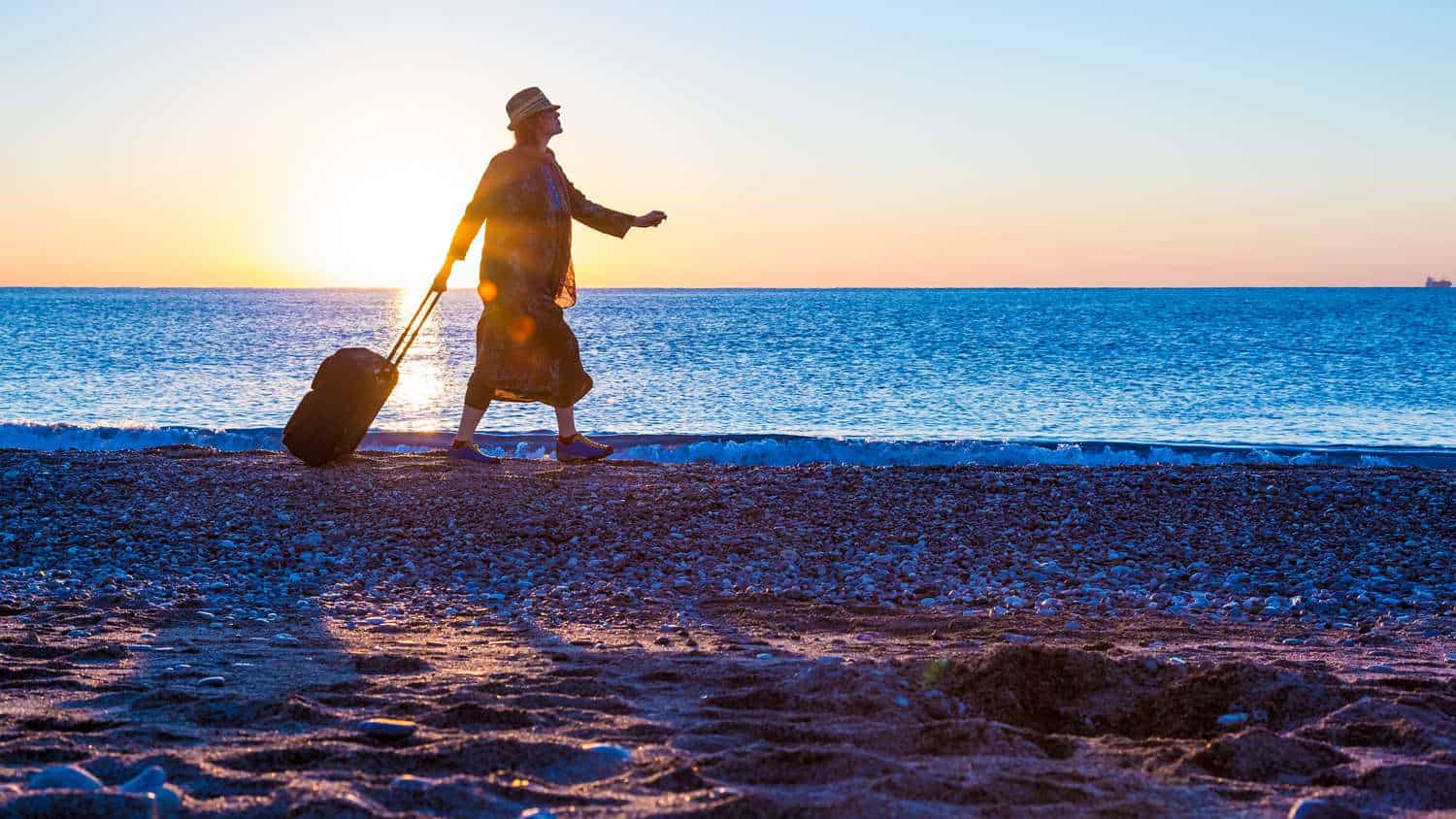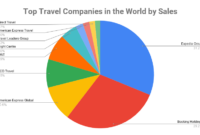Senior women travel is experiencing a surge in popularity, with women embracing adventure and exploration in their later years. This isn’t just about ticking destinations off a bucket list; it’s about personal growth, connection, and creating unforgettable memories. This guide explores everything from choosing the perfect destination and managing your budget to prioritizing health and safety while traveling solo or with friends. We’ll delve into practical tips for planning, packing, and navigating cultural nuances, ensuring a fulfilling and worry-free experience.
From carefully curated itineraries to essential safety considerations, we aim to empower senior women to confidently embark on the journey of a lifetime. Whether you dream of exploring bustling Asian markets or relaxing on pristine European beaches, this comprehensive guide will equip you with the knowledge and resources to plan your ideal trip. We’ll cover everything from budget-friendly options to luxury getaways, ensuring that your travel experience is both enriching and tailored to your specific needs and preferences.
Travel Destinations Popular with Senior Women
Planning a trip as a senior woman offers a wonderful opportunity for relaxation, exploration, and creating lasting memories. Choosing the right destination is key to ensuring a comfortable and enriching experience. This section highlights ten popular destinations, categorized by region, considering factors important to mature travelers.
Popular Travel Destinations for Senior Women
The following list presents ten destinations favored by senior women, considering factors such as safety, accessibility, cultural richness, and manageable travel pace. These locations offer a variety of experiences, catering to diverse interests and preferences.
- Europe: Portugal (Lisbon & Porto): Charming cities with walkable historic centers, delicious cuisine, and a relaxed atmosphere. Excellent public transportation makes navigation easy.
- Europe: Italy (Tuscany): Picturesque countryside, stunning art and architecture, and delicious food and wine. Many agriturismos (farm stays) offer comfortable and accessible accommodations.
- Europe: Switzerland (Lucerne & Interlaken): Breathtaking mountain scenery, pristine lakes, and charming towns. Excellent train service connects various attractions, reducing reliance on cars.
- Asia: Japan (Kyoto & Tokyo): A blend of ancient traditions and modern amenities. Kyoto offers serene temples and gardens, while Tokyo provides vibrant city life with easy navigation.
- Asia: Vietnam (Hanoi & Hoi An): Rich culture, delicious food, and stunning landscapes. Hoi An offers a relaxed pace, while Hanoi provides a bustling city experience.
- North America: Canada (Vancouver & Banff): Stunning natural beauty, from mountains to coastlines. Vancouver offers a vibrant city, while Banff provides access to national parks.
- North America: United States (Charleston, South Carolina): Historic charm, Southern hospitality, and beautiful architecture. Walkable city center with easy access to attractions.
- South America: Peru (Cusco & Machu Picchu): Inca history and breathtaking mountain scenery. While physically demanding, organized tours cater to different fitness levels.
- Oceania: New Zealand (Queenstown & Auckland): Stunning landscapes, from fjords to mountains. Organized tours offer a comfortable way to experience the beauty of the country.
- Africa: Morocco (Marrakech & Fes): A vibrant culture, bustling souks (markets), and beautiful architecture. While potentially overwhelming, guided tours can enhance the experience.
Comparison of Destinations for Senior Women Travelers
This table compares the destinations based on cost (low, medium, high), accessibility (excellent, good, fair), and cultural experiences (rich, moderate, limited). These are general estimations and can vary based on travel style and time of year.
| Destination | Cost | Accessibility | Cultural Experiences |
|---|---|---|---|
| Portugal | Medium | Excellent | Rich |
| Italy (Tuscany) | Medium-High | Good | Rich |
| Switzerland | High | Excellent | Moderate |
| Japan | Medium-High | Excellent | Rich |
| Vietnam | Low-Medium | Good | Rich |
| Canada | Medium-High | Excellent | Moderate |
| Charleston, SC | Medium | Good | Moderate |
| Peru | Medium-High | Fair | Rich |
| New Zealand | High | Good | Moderate |
| Morocco | Low-Medium | Fair | Rich |
Unique Activities and Experiences for Senior Women Travelers
Each destination offers unique experiences tailored to the interests of senior women. These experiences prioritize comfort, ease of access, and cultural immersion.
- Portugal: A leisurely walking tour of Lisbon’s Alfama district, followed by a Fado music performance.
- Italy (Tuscany): A cooking class focusing on regional specialties, followed by a wine tasting at a local vineyard.
- Switzerland: A scenic train journey through the Swiss Alps, with stops at charming mountain villages.
- Japan: A traditional tea ceremony, followed by a visit to a serene Zen garden.
- Vietnam: A cooking class focusing on Vietnamese cuisine, followed by a boat trip along the Perfume River.
- Canada: A scenic drive through Banff National Park, with stops at stunning viewpoints and hot springs.
- Charleston, SC: A horse-drawn carriage ride through the historic city center, followed by a visit to a plantation.
- Peru: A guided tour of Machu Picchu, with options for less strenuous hikes.
- New Zealand: A scenic cruise through Milford Sound, followed by a visit to a local craft market.
- Morocco: A guided tour of the Marrakech souks, followed by a traditional hammam experience.
Health and Wellness Considerations for Senior Women Travelers
Planning an international trip as a senior woman requires careful consideration of health and wellness. Prioritizing your well-being ensures a safe and enjoyable experience, maximizing the benefits of travel while minimizing potential risks. This section outlines essential precautions and strategies to maintain your health throughout your journey.
Pre-Travel Health Preparations
Before embarking on your adventure, a comprehensive health check-up is crucial. This should include consultations with your primary care physician and any specialists managing pre-existing conditions like heart disease, diabetes, or respiratory issues. Discuss potential health risks associated with your destination, such as infectious diseases, and obtain necessary vaccinations and preventative medications. Pack a well-stocked first-aid kit containing prescription medications, over-the-counter pain relievers, anti-diarrheal medication, and any personal medical supplies. Consider carrying a detailed medical history document, including a list of allergies and current medications, in both your native language and English. A copy should also be left with a trusted contact at home.
Managing Pre-existing Medical Conditions During Travel
For senior women with pre-existing medical conditions, meticulous planning is paramount. Ensure you have an adequate supply of necessary medications, exceeding the anticipated trip duration to account for potential delays. Carry medications in their original containers with labels clearly indicating dosage and usage instructions. Consult your doctor regarding potential medication interactions or adjustments needed due to changes in climate or time zones. Consider carrying a portable medical device, if necessary, and familiarize yourself with its operation and any potential issues that might arise during travel. Pack a small, lightweight medical kit with essential supplies to manage any minor flare-ups of pre-existing conditions.
Travel Insurance for Senior Travelers
Comprehensive travel insurance is essential for senior women travelers. Standard policies may not provide sufficient coverage for age-related health issues or medical emergencies. Seek out specialized senior travel insurance plans that offer extensive medical evacuation coverage, repatriation of remains, and coverage for pre-existing conditions (subject to specific policy terms and conditions). Compare policies from multiple providers to find the best fit for your needs and budget, paying attention to coverage limits, exclusions, and any required pre-existing condition waivers. Remember that the cost of medical care abroad can be significantly higher than at home, so adequate insurance coverage is a vital safeguard. For example, a policy with a high medical evacuation limit could be crucial if you require emergency transport back to your home country.
Maintaining Physical Fitness and Mental Well-being During Travel
Maintaining physical fitness and mental well-being is vital for enjoying your trip.
- Engage in light exercise daily, such as walking, stretching, or gentle yoga, to maintain flexibility and circulation.
- Stay hydrated by drinking plenty of water throughout the day, especially in hot climates.
- Prioritize nutritious meals and snacks to maintain energy levels and support your immune system.
- Get adequate sleep to combat fatigue and prevent illness.
- Schedule downtime for relaxation and stress reduction through activities like reading, meditation, or enjoying scenic views.
- Connect with fellow travelers or locals to combat loneliness and foster a sense of community.
- Maintain regular contact with family and friends back home to stay connected and share your experiences.
Post-Travel Health Considerations
Upon returning home, schedule a follow-up appointment with your doctor to discuss any health concerns that may have arisen during your travels. This is particularly important if you experienced any illnesses or injuries. Be mindful of potential jet lag and allow your body time to readjust to its normal routine. Continue to practice healthy habits to maintain your overall well-being.
Budgeting and Financial Planning for Senior Women’s Trips
Planning a trip, especially as a senior woman, requires careful consideration of finances. A well-structured budget ensures a stress-free and enjoyable experience, regardless of the trip’s length or style. This section will outline strategies for budgeting, cost-saving techniques, and payment methods for senior women travelers.
Budgeting Strategies for Different Trip Styles and Lengths
The budget for a senior woman’s trip will significantly vary depending on the trip’s duration and desired level of luxury. A two-week luxury cruise to the Mediterranean will naturally demand a far larger budget than a week-long backpacking adventure in Southeast Asia. Before embarking on any trip planning, it’s crucial to determine a realistic budget based on your savings and spending habits. For instance, a budget-conscious traveler might allocate $100 per day for a trip to a moderately priced destination, while a luxury traveler might allocate $500 or more. Consider creating a spreadsheet detailing expected expenses across categories like flights, accommodation, activities, food, and souvenirs. This allows for better tracking and adjustment throughout the planning process.
Cost-Saving Techniques for Accommodation, Transportation, and Activities
Several strategies can significantly reduce travel costs without compromising the overall experience. For accommodation, consider alternatives to expensive hotels, such as Airbnb for homestays or guesthouses offering more affordable rates and a local experience. For transportation, utilizing public transportation or ride-sharing services can be considerably cheaper than renting a car, particularly in densely populated urban areas. For activities, research free or low-cost options such as visiting parks, museums on free admission days, or taking advantage of free walking tours. Booking flights and accommodations well in advance often secures better deals, while traveling during the off-season can dramatically lower costs. Packing light minimizes baggage fees and simplifies travel.
Comparison of Payment Methods for International Travel
Choosing the right payment method for international travel is crucial for security and minimizing fees. Credit cards often offer purchase protection and travel insurance benefits, but be aware of foreign transaction fees, which can add up significantly. Debit cards can be more secure than carrying large amounts of cash, but may also incur foreign transaction fees and may not be accepted everywhere. Prepaid travel cards can help manage spending and avoid overspending, but ensure you understand any associated fees and exchange rates. Carrying a small amount of local currency is advisable for smaller purchases and emergencies. Always inform your bank and credit card companies of your travel plans to prevent any issues with card usage abroad. Consider the security implications of each method; for example, credit cards offer better fraud protection than cash.
Safety and Security for Senior Women Traveling Solo or in Groups
Traveling, especially for senior women, requires careful consideration of safety and security. Whether venturing solo or with companions, proactive measures can significantly enhance peace of mind and minimize potential risks. This section will explore potential hazards, preventative strategies, and valuable resources to ensure a safe and enjoyable travel experience.
Potential Safety Concerns for Senior Women Travelers
Senior women may face unique safety challenges while traveling, both domestically and internationally. These include, but are not limited to, petty theft (such as pickpocketing or bag snatching in crowded areas), scams targeting tourists, unexpected health emergencies requiring immediate medical attention, and incidents of harassment or assault. The vulnerability may be heightened when traveling alone, but even in groups, vigilance remains crucial. Furthermore, physical limitations associated with aging can increase the risk of accidents, such as falls or injuries.
Preventative Measures to Enhance Safety
Prior planning and awareness are key to minimizing risks. Before departure, research the destination thoroughly, paying attention to local customs, laws, and potential safety concerns. Share detailed itinerary information with family or friends, including flight numbers, hotel addresses, and planned activities. Carry copies of important documents (passport, visas, insurance information) separately from the originals, ideally stored electronically in a cloud-based system accessible offline. Utilize hotel safes for valuables, and avoid displaying expensive jewelry or electronics openly. Consider learning a few basic phrases in the local language to facilitate communication in case of emergencies. Finally, trust your instincts; if a situation feels unsafe, remove yourself from it immediately.
Resources and Tools for Ensuring Safety and Security
Several resources and technologies can bolster safety while traveling. Travel apps such as GPS trackers, emergency alert systems, and translation apps can prove invaluable. Many offer features for sharing real-time location with trusted contacts and summoning emergency services with a single button. Consider purchasing a personal safety alarm, easily activated in emergencies to attract attention. International roaming plans for mobile phones can provide essential communication capabilities, while travel insurance provides financial protection in case of medical emergencies, trip cancellations, or lost belongings. Embassy or consulate contact information should be readily available, particularly for international travel.
Comparing Travel Styles: Safety and Security Implications
The choice of travel style – solo, group tours, or cruises – significantly impacts safety and security. Solo travel offers independence but requires heightened self-reliance and awareness of potential risks. Group tours provide a sense of security and shared responsibility, with a tour leader often handling logistics and providing guidance. Cruises offer a contained environment with readily available support, but incidents can still occur, and disembarking in ports requires the same vigilance as independent travel. The optimal choice depends on individual preferences, comfort levels, and physical capabilities. Careful consideration of these factors is vital for planning a safe and enjoyable trip.
Packing Essentials and Travel Gear for Senior Women
Packing efficiently and comfortably is crucial for a stress-free senior women’s trip. Careful consideration of clothing choices, essential medical supplies, and helpful travel gadgets can significantly enhance the overall travel experience. This section details a suggested packing list and organizational strategies to maximize comfort and minimize hassle.
Clothing and Footwear
Selecting comfortable and practical clothing is paramount for senior travelers. Prioritize breathable, lightweight fabrics that are easy to care for. Avoid restrictive clothing items. Choosing versatile pieces that can be mixed and matched reduces the overall quantity needed.
- Tops: 7-10 lightweight, breathable tops (e.g., cotton, linen blends). Consider moisture-wicking fabrics for warmer climates.
- Bottoms: 3-4 pairs of comfortable trousers or skirts (avoid tight-fitting styles). Consider travel pants with zippered pockets for security.
- Dresses/Jumpers: 2-3 versatile dresses or jumpers that can be layered.
- Underwear and Socks: Pack enough for each day, plus a few extra. Choose comfortable, breathable materials.
- Outerwear: A lightweight jacket or sweater for layering, and a waterproof, windproof jacket for inclement weather.
- Pajamas: Comfortable and lightweight pajamas.
- Shoes: Comfortable, supportive walking shoes are essential. Pack a pair of slip-on shoes or sandals for easy on and off. Consider orthotic inserts if needed.
- Accessories: A lightweight scarf, hat, and sunglasses for sun protection.
Essential Travel Gadgets and Accessories
Technology and helpful accessories can significantly improve comfort and convenience during travel. Prioritize items that enhance safety, mobility, and communication.
- Portable Charger: Essential for keeping electronic devices charged while on the go.
- Travel Pillow: Provides neck and head support during flights or long journeys.
- Medication Organizer: Helps keep track of medications and ensures proper dosage.
- Walking Stick or Cane: If needed, provides stability and support during walks.
- Magnifying Glass: Aids in reading small print on maps or menus.
- Universal Adapter: Essential for charging electronic devices in different countries.
- Lightweight Backpack or Tote Bag: For carrying essentials during day trips.
Packing Cube System
Visualize a medium-sized suitcase. The bottom third is filled with two large packing cubes: one for bottoms (trousers, skirts), and one for tops (shirts, blouses). The middle third contains two smaller packing cubes: one for underwear and socks, and one for pajamas and other sleepwear. The top third holds a smaller cube for toiletries, and the remaining space is for shoes and accessories. This allows for efficient organization and easy access to items. Items like a lightweight jacket are placed on top for easy access.
Final Review
Ultimately, senior women travel is about embracing independence, discovering new cultures, and forging lasting connections. By carefully considering the health, safety, and logistical aspects of your trip, you can create a truly enriching and unforgettable experience. Remember that planning is key, and with the right preparation, the world is your oyster. Embrace the adventure, embrace the journey, and create memories that will last a lifetime. Safe travels!




